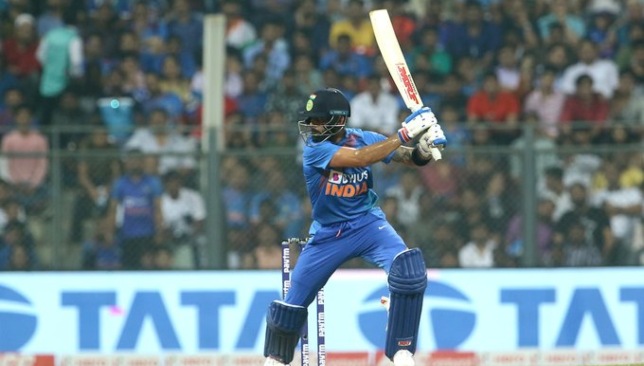
It was raining down sixes at the Wankhede stadium in Mumbai on Wednesday as India clinched the T20I series against the West Indies in emphatic style. 28 sixes were thumped in total by both sides with the hosts alone accounting for 17 of them.
The emphatic 67-run win extended India’s formidable record in bilateral T20I deciders, but it was the manner in which the victory was achieved which was most significant. For long, India’s approach to limited-overs cricket has centered on taking a conservative approach in the initial overs with the preservation of wickets taking utmost priority.
It is a game plan which has served them well in the ODI format, though it is one which puts greater onus on the top-three batsmen to do the bulk of scoring for the team. That India’s top three have been made up of Rohit Sharma, Shikhar Dhawan and skipper Virat Kohli for a large part of the last few years has meant that the strategy has paid off more often than not.
The trio is, after all, one of the most consistent, particularly in the ODI format. But while that approach has worked like a charm for the most part in the 50-over game, it was starting to run a bit stale in the T20 format where other top sides have been trying to push the limits and barriers of run-scoring.
With most sides now packing their sides with capable batsmen down to No8 or No9, attacking the ball from the very go has become the common mantra in T20Is. England have done it, so have two-time world champions West Indies, while Australia are starting to adopt that method as well.
Not many expected india to lose a series .. win was not a surprise .. what will stand out is the fearless batting which all will see in T20 now ..play without fear .. no one plays for his place but plays to win ..well done india @BCCI @imVkohli @JayShah @ImRo45
— Sourav Ganguly (@SGanguly99) December 11, 2019
It is no surprise then, that skipper Kohli and the Indian team management have advocated for a shift in how the T20I team approaches their batting. With the World Cup in Australia now less than a year away, the sense of urgency has grown with India experimenting their new game plan at different stages in recent home series against South Africa and Bangladesh.
Bowling all-rounders such as Washington Sundar, Shivam Dube, Ravindra Jadeja and even Deepak Chahar have been given prominent roles to extend India’s batting depth. Still, the results of this new strategy have been a mixed bag so far with the Men in Blue sometimes being caught in two minds over whether to attack or conserve.
Slowly, but surely, India are now starting to get the hang of it with the series against West Indies a testament to their willingness to adapt to modern times. The injury to Dhawan and KL Rahul’s subsequent promotion to the opening slot has been a blessing in disguise to this end.
Rahul, Rohit and Kohli have forged a terrific trio, with the latter two also shedding their image of being slow starters. That Windies were India’s opponents for the latest series turned out to be a boon with the reigning world champions bringing with them a flair that showed that no total could be considered safe.
That fear has pushed India even harder to up the scoring ante in the three-match series, and the Men in Blue have emerged far stronger for it. The 240-3 they put up in Mumbai is their third highest score in the format, with Rahul, Rohit and Kohli themselves accounting for 232 of those runs.
While Rohit’s monstrous six-hitting ability has been all too well known, it is the 13 sixes slammed by Kohli in the series that proves that India have changed their modus operandi. The India skipper has never been one about hitting the big boundaries, with quick running between the wickets and classical shot-making being his usual forte. He, though, has led from the front a revolution which touched new zeniths on Wednesday at the Wankhede.
Virat Kohli during the 3rd T20I:
— Sampath Bandarupalli (@SampathStats) December 11, 2019
- Most sixes in a T20I series/tourney for India (13 sixes)
- First Indian with 1000+ T20I runs at home (1064 runs)
- Fastest INTL fifty by an Indian captain (21 balls)
- 6th player of the series award in T20I cricket#INDvWI
Registering his fastest T20I fifty (21 balls), Kohli scored his 70 runs at a strike-rate of over 241. Rahul’s 91 came at a rate of 162.5 while Rohit’s 71 were scored at 208.82. In two of three T20s, India sent in a pinch-hitter at No3 instead of Kohli: It was Dube who took the slot in the second match while it was Rishabh Pant who was promoted in the decider.
That shows India’s newfound intent, and it is one with which they should persevere in the run-up to next year’s World Cup. Sure, the strategy might backfire on them on more than one occasion, but it is a price they should be willing to pay if they are to go all the way in Australia. The fear of failure has to be put behind if greatness and trophies are to be achieved.
In a T20 world of cricket where madness has become the norm, it will be a survival of the fittest. No longer could India afford to be tame and conservative, and they are now finally starting to show their wild side.